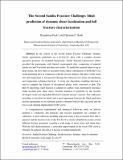The second Sandia Fracture Challenge: blind prediction of dynamic shear localization and full fracture characterization
Author(s)
Pack, Keun Hwan; Roth, Richard
Download10704_2016_91_ReferencePDF.pdf (3.142Mb)
PUBLISHER_POLICY
Publisher Policy
Article is made available in accordance with the publisher's policy and may be subject to US copyright law. Please refer to the publisher's site for terms of use.
Terms of use
Metadata
Show full item recordAbstract
In the context of the second Sandia Fracture Challenge, dynamic tensile experiments performed on a Ti–6Al–4V alloy with a complex fracture specimen geometry are modeled numerically. Sandia National Laboratories provided the participants with limited experimental data, comprising of uniaxial tensile test and V-notched rail shear test results. To model the material behavior up to large plastic strains, the flow stress is described with a linear combination of Swift and Voce strain hardening laws in conjunction with the inverse method. The effect of the strain rate and temperature is incorporated through the Johnson–Cook strain rate hardening and temperature softening functions. A strain rate dependent weighting function is used to compute the fraction of incremental plastic work converted to heat. The Hill’48 anisotropic yield function is adopted to capture weak deformation resistance under in-plane pure shear stress. Fracture initiation is predicted by the recently developed strain rate dependent Hosford–Coulomb fracture criterion. The calibration procedure is described in detail, and a good agreement between the blind prediction and the experiments at two different speeds is obtained for both the crack path and the force–crack opening displacement (COD) curve. A comprehensive experimental and numerical follow-up study on leftover material is conducted, and plasticity and fracture parameters are carefully re-calibrated. A more elaborate modeling approach using a non-associated flow rule is pursued, and the fracture locus of the Ti–6Al–4V is clearly identified by means of four different fracture specimens covering a wide range of stress states and strain rates. With the full characterization, a noticeable improvement in the force–COD curve is obtained. In addition, the effect of friction is studied numerically.
Date issued
2016-02Department
Massachusetts Institute of Technology. Department of Mechanical Engineering; Massachusetts Institute of Technology. Impact and Crashworthiness LaboratoryJournal
International Journal of Fracture
Publisher
Springer Netherlands
Citation
Pack, Keunhwan, and Christian C. Roth. “The Second Sandia Fracture Challenge: Blind Prediction of Dynamic Shear Localization and Full Fracture Characterization.” International Journal of Fracture 198, no. 1–2 (February 22, 2016): 197–220.
Version: Author's final manuscript
ISSN
0376-9429
1573-2673